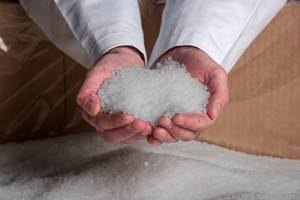The Fantasy and Reality of Raw Material Shelf Life: Part 2
For the vast majority of thermoplastics, the stability of the materials can be stated in years, not months. But there are exceptions where shelf life can be a serious issue.
The idea of material expiring as it sits on the shelf in the warehouse is often a concept with no scientific basis, as we discussed last month. However, there are materials that do have a shelf life. The majority of these are thermosetting materials, either rigid or elastomeric.
The time-sensitive nature of crosslinked materials is related to the composition of these materials and specifically to the fact these compounds, as provided to the molder, are not completely formed polymers and the catalyst that aids in completing the polymerization and crosslinking process is a constituent in the compound. This catalyst, because it is chemically active, can react prematurely or it can volatilize and be lost to the system.
Most of my time in manufacturing was spent at a company that did both thermoplastic and thermoset molding. We were never concerned with the shelf-life stability of our thermoplastic materials. But some of our thermoset compounds were a different story. We processed a particular grade of melamine-phenolic resin that had to be processed within nine months of being received from the supplier. Failure to do so would result in a material that would not crosslink. This was a demonstrable phenomenon and lab analysis confirmed that the energy associated with crosslinking would not be detected if an old sample of the material was tested.
Bulk molding compounds (BMC) and sheet molding compounds (SMC), a type of unsaturated polyester, utilize styrene as a key ingredient. The styrene is used to “dissolve” or soften the low molecular weight linear polyester prepolymer and participates in the crosslinking reaction which is promoted by a free radical initiator. Walking past racks of this material in the plant, the smell of styrene is evident. This confirms that some of the styrene in the compound is volatilizing.
Styrene as a Plasticizer
Over time, while the material sits in storage, it will become less pliable and somewhat harder because the styrene is essentially acting as a plasticizer. This will influence processing of the material, affecting the time required to achieve minimum viscosity, gel time and degree of crosslinking. If it is stored for long enough, the material may become intractable. We achieved a much longer shelf life for this material in our facility by building a refrigerated storage room where we kept the raw material until a day or two before we were ready to run it. This also made the material more consistent over time.
I encountered an extreme version of this while working on some epoxy parts molded for field effect transformers. Some of the parts were exhibiting defects associated with premature curing that prevented the material from flowing into the mold properly. The problem was traced to the way the material was being handled prior to processing. This particular compound had to be kept at very cold conditions until three days before processing.
It was then brought out of the refrigerated storage room and gradually warmed to room temperature over a two-day period and then had to be processed on the third day. If it sat at room temperature for any longer, or if the temperature of the room increased due to seasonal fluctuations, the defects associated with premature crosslinking would appear. These are clear instances of true shelf life concerns. They apply to a wide range of crosslinkable materials (including rubber compounds) where — depending upon the polymer type and the cure system — shelf life of the pre-cured compound can be as little as 2-3 weeks.
In plasticized materials and particularly in crosslinked systems prior to processing, shelf life can be a real concern.
Another class of materials where shelf life of the raw material is a consideration are thermoplastic elastomers that rely on the use of plasticizers. Plasticizers are typically fluids that are blended with the polymer to achieve a balance of properties. They are usually of lower molecular weight than the polymer and are therefore prone to migration. The rate of this migration is increased at higher temperatures; and in molded components, the process can also be accelerated by direct contact with mating parts made from materials that can absorb the plasticizer. In the raw material, this migration will be governed by a variety of considerations which include temperature and humidity.
Therefore, storage conditions are a critical factor in determining shelf life, including whether the material is still in its original packaging and whether that packaging has been compromised. Flexible PVC and plasticized nylons are among the materials that can change over time. The suppliers of the raw materials tend to understate the amount of time the material can be stored without exhibiting a loss in performance, but problems have been shown to occur in materials of this type over a period of a few years even with good storage practices.
Storage Conditions Matter
This brings us to the topic of storage conditions. Generally, the lower the temperature and humidity at which the material is stored the longer it will maintain its integrity and processability. Exposure to ultraviolet light, ozone, and nitrogen and sulfur oxides produced by combustion will also shorten the shelf life of a material and potentially produce changes in the color of the product as well. Most warehouses where raw material is stored are not climate controlled. Therefore, depending upon the location, temperatures and humidity can become elevated for much of the year.
One February, I worked for a week at a plant in Chennai, India, where the outdoor daytime temperature was already reaching 90oF (32oC) and the temperature in the warehouse was considerably higher. These types of conditions can have a variety of accelerating effects on the stability of a material.
When in doubt, testing will determine whether storage conditions influence the integrity of the material.
Silo storage introduces another set of variables that can include rapid changes in relative humidity. And, finally, there are the situations where due to a lack of indoor warehouse space, raw material is simply placed outdoors where the elements of sunlight, changes in temperature and humidity, and pollutants in the air can act with greater effect on the material — regardless of whether it is in its original package or has been transferred to a secondary container.
In summary, shelf life is a factor to be considered when managing material storage. For the vast majority of thermoplastics, the stability of the materials can be stated in years, not months, and the notion that a polymer expires like a food or a pharmaceutical is a fanciful notion that may be used by material suppliers to absolve them of responsibility for an out-of-specification condition. However, in plasticized materials and particularly in crosslinked systems prior to processing, shelf life can be a real concern and extra measures such as refrigeration can and should be used to extend the useful life of a product.
When in doubt, testing will determine whether storage conditions influence the integrity of the material. Specimens molded from a new lot of raw material and the older lot can be tested for mechanical performance. In the case of crosslinkable rubber compounds, torque rheometry can be performed to characterize the time required to achieve minimum viscosity and cure. These objective measurements replace the vague statements about shelf life that often serve as a belief system devoid of science.
ABOUT THE AUTHOR: Michael Sepe is an independent materials and processing consultant based in Sedona, Arizona, with clients throughout North America, Europe and Asia. He has more than 45 years of experience in the plastics industry and assists clients with material selection, designing for manufacturability, process optimization, troubleshooting and failure analysis. Contact: 928-203-0408 • mike@thematerialanalyst.com.
Related Content
Prices Up for All Volume Resins
First quarter was ending up with upward pricing, primarily due to higher feedstock costs and not supply/demand fundamentals.
Read More‘Monomaterial’ Trend in Packaging and Beyond Will Only Thrive
In terms of sustainability measures, monomaterial structures are already making good headway and will evolve even further.
Read MoreCommodity Resin Prices Flat to Lower
Major price correction looms for PP, and lower prices are projected for PE, PS, PVC and PET.
Read MoreThe Effects of Stress on Polymers
Previously we have discussed the effects of temperature and time on the long-term behavior of polymers. Now let's take a look at stress.
Read MoreRead Next
See Recyclers Close the Loop on Trade Show Production Scrap at NPE2024
A collaboration between show organizer PLASTICS, recycler CPR and size reduction experts WEIMA and Conair recovered and recycled all production scrap at NPE2024.
Read MoreBeyond Prototypes: 8 Ways the Plastics Industry Is Using 3D Printing
Plastics processors are finding applications for 3D printing around the plant and across the supply chain. Here are 8 examples to look for at NPE2024.
Read MorePeople 4.0 – How to Get Buy-In from Your Staff for Industry 4.0 Systems
Implementing a production monitoring system as the foundation of a ‘smart factory’ is about integrating people with new technology as much as it is about integrating machines and computers. Here are tips from a company that has gone through the process.
Read More
.jpg;width=70;height=70;mode=crop)






















